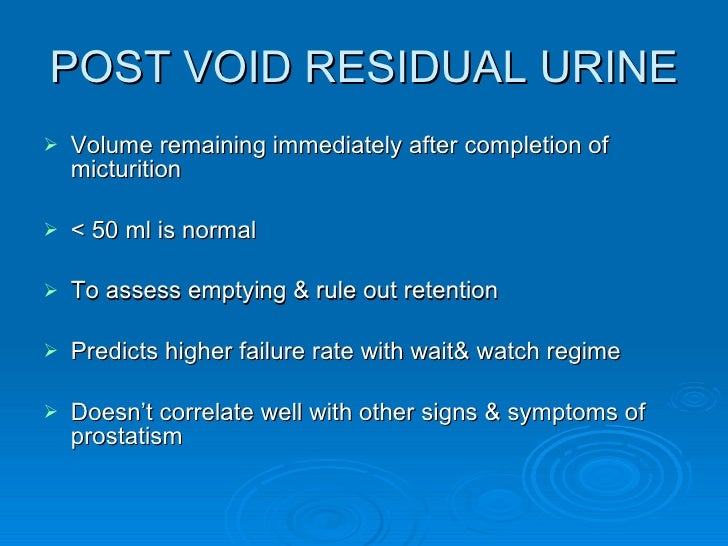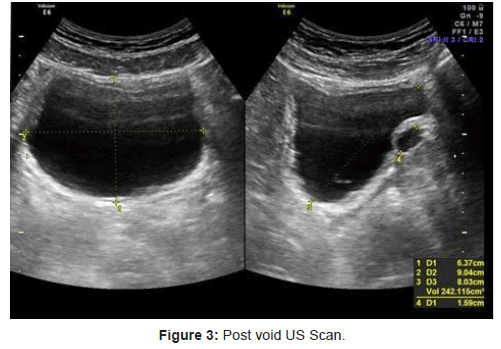
Section 1862(a)(1)(A) excludes expenses incurred for items or services which are not reasonable and necessary for the diagnosis or treatment of illness or injury or to improve the functioning of a malformed body member. Title XVIII of the Social Security Act (SSA): Unless otherwise specified, italicized text represents quotation from one or more of the following CMS sources: See Section 1869(f)(1)(A)(i) of the Social Security Act. In addition, an administrative law judge may not review an NCD.
#Post void bladder volume normal manuals
NCDs and coverage provisions in interpretive manuals are not subject to the Local Coverage Determination (LCD) Review Process (42 CFR 405.860 and 42 CFR 426 ). Not endorsed by the AHA or any of its affiliates.ĬMS National Coverage Policy Language quoted from Centers for Medicare and Medicaid Services (CMS), National Coverage Determinations (NCDs) and coverage provisions in interpretive manuals is italicized throughout the policy. Presented in the material do not necessarily represent the views of the AHA. Preparation of this material, or the analysis of information provided in the material. The American Hospital Association (the "AHA") has not reviewed, and is not responsible for, the completeness orĪccuracy of any information contained in this material, nor was the AHA or any of its affiliates, involved in the
#Post void bladder volume normal manual
Resale and/or to be used in any product or publication creating any modified or derivative work of the UB‐04 Manual and/or codes and descriptions Īnd/or making any commercial use of UB‐04 Manual or any portion thereof, including the codes and/or descriptions, is onlyĪuthorized with an express license from the American Hospital Association. Making copies or utilizing the content of the UB‐04 Manual, including the codes and/or descriptions, for internal purposes, If an entity wishes to utilize any AHA materials, please contact the AHA at 312‐893‐6816. AHA copyrighted materials including the UB‐04 codes andĭescriptions may not be removed, copied, or utilized within any software, product, service, solution or derivative work No portion of the American Hospital Association (AHA) copyrighted materials contained within this publication may beĬopied without the express written consent of the AHA. All rights reserved.Ĭopyright © 2023, the American Hospital Association, Chicago, Illinois.

The AMA assumes no liability for data contained or not contained herein.Ĭurrent Dental Terminology © 2022 American Dental Association. The AMA does not directly or indirectly practice medicine or dispense medical services. Applicable FARS/HHSARS apply.įee schedules, relative value units, conversion factors and/or related components are not assigned by the AMA, are not part of CPT, and the AMA is not per 4 hours).ĭuring the first 3 years of life the number of voiding episodes, including interrupted voiding, post-void residual urine and voiding during sleep, decreased while bladder capacity increased.AMA CPT / ADA CDT / AHA NUBC Copyright StatementĬPT codes, descriptions and other data only are copyright 2022 American Medical Association. As measured by post-void residual urine volume, bladder emptying was unchanged during years 1 and 2 but it decreased during year 3 (median 6 versus 0 and mean 4 versus 3 ml. Bladder capacity increased from a median of 52 to 67, 68 and 123 ml. Voiding during sleep occurred mainly during the first 7 months of life and did not continue after age 18 months.

We noted interrupted voiding in 33% of subjects at age 3 months but this condition was rare after age 2 years. Voiding frequency decreased slowly from 5 to 2 voiding episodes per 4 hours from ages 3 months to 3 years.

We determined voiding patterns, bladder capacity and post-void residual urine volume per 4 hours individually and noninvasively every 3 months in 36 female and 23 male healthy infants using the 4-hour voiding observation. We describe the development of voiding patterns and bladder control in healthy children during the first 3 years of life.


 0 kommentar(er)
0 kommentar(er)
